Related Research Articles

A textile is a flexible material made by creating an interlocking network of yarns or threads, which are produced by spinning raw fibres into long and twisted lengths. Textiles are then formed by weaving, knitting, crocheting, knotting, tatting, felting, bonding or braiding these yarns together.
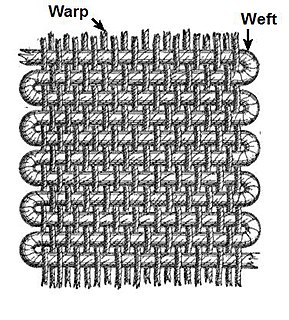
Weaving is a method of textile production in which two distinct sets of yarns or threads are interlaced at right angles to form a fabric or cloth. Other methods are knitting, crocheting, felting, and braiding or plaiting. The longitudinal threads are called the warp and the lateral threads are the weft, woof, or filling. The method in which these threads are inter-woven affects the characteristics of the cloth. Cloth is usually woven on a loom, a device that holds the warp threads in place while filling threads are woven through them. A fabric band which meets this definition of cloth can also be made using other methods, including tablet weaving, back strap loom, or other techniques without looms.

Crewel embroidery, or crewelwork, is a type of surface embroidery using wool. A wide variety of different embroidery stitches are used to follow a design outline applied to the fabric. The technique is at least a thousand years old.

Poplin, also called tabinet, is a fine, but thick, wool, cotton or silk fabric that has a horizontal warp and a vertical weft. Nowadays, it is a strong fabric in a plain weave of any fiber or blend, with crosswise ribs that typically gives a corded surface.

Flannel is a soft woven fabric, of various fineness. Flannel was originally made from carded wool or worsted yarn, but is now often made from either wool, cotton, or synthetic fiber.

A bathrobe, also known as a housecoat, is a robe, a loose-fitting outer garment, worn by people. Bathrobes may sometimes be worn after a body wash or around a pool.

Bombazine, or bombasine, is a fabric originally made of silk or silk and wool, and now also made of cotton and wool or of wool alone. Quality bombazine is made with a silk warp and a worsted weft. It is twilled or corded and used for dress-material. Black bombazine was once used largely for mourning wear, but the material had gone out of fashion by the beginning of the 20th century.
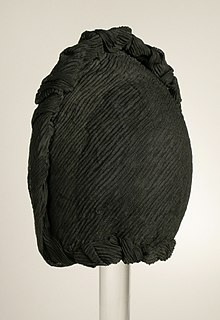
Crêpe, also spelt crepe or crape is a silk, wool, or synthetic fiber fabric with a distinctively crisp and crimped appearance. The term "crape" typically refers to a form of the fabric associated specifically with mourning. Crêpe was also historically called "crespe" or "crisp".

A stocking frame was a mechanical knitting machine used in the textiles industry. It was invented by William Lee of Calverton near Nottingham in 1589. Its use, known traditionally as framework knitting, was the first major stage in the mechanisation of the textile industry, and played an important part in the early history of the Industrial Revolution. It was adapted to knit cotton and to do ribbing, and by 1800 had been adapted as a lace making machine.
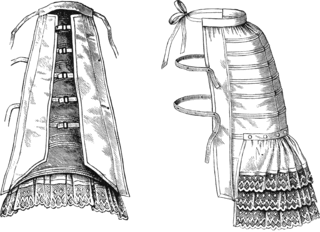
Dimity is a lightweight, sheer cotton fabric, used historically, having at least two warp threads thrown into relief to form fine cords. It is a cloth commonly employed for bed upholstery and curtains, and usually white, though sometimes a pattern is printed on it in colors. It is stout in texture, and woven in raised patterns. Originally dimity was made of silk or wool, but since the 18th century it has been woven almost exclusively of cotton.
The manufacture of textiles is one of the oldest of human technologies. To make textiles, the first requirement is a source of fibre from which a yarn can be made, primarily by spinning. The yarn is processed by knitting or weaving, which turns yarn into cloth. The machine used for weaving is the loom. For decoration, the process of colouring yarn or the finished material is dyeing. For more information of the various steps, see textile manufacturing.
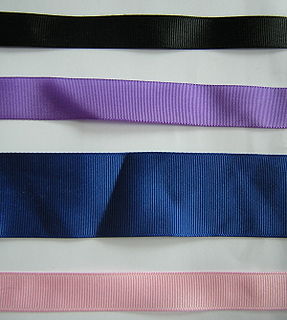
Grosgrain, is a type of fabric or ribbon defined by the fact that its weft is heavier than its warp, creating prominent transverse ribs. It is called a "corded" fabric since the weft resembles a fine cord. Grosgrain is a plain weave corded fabric, with heavier cords than in poplin but lighter than in faille. Grosgrain has a very dull appearance with little luster but is very strong. It is a firm, close-woven, fine-corded fabric. Grosgrain fabric is most commonly available in black, but grosgrain ribbon comes in a large variety of colors and patterns. The ribbon is very similar to Petersham ribbon in its appearance, but it does not have the ability to follow the curves of a surface or edge the way that the latter does.

Embroidery thread is yarn that is manufactured or hand-spun specifically for embroidery and other forms of needlework.

Hereke carpets are Turkish handmade carpets produced and sold in Hereke, a coastal town in Turkey. For a long time, they used to be produced only in Hereke, 60 km from Istanbul. The materials used are silk, a combination of wool and cotton, and sometimes gold or silver threads.
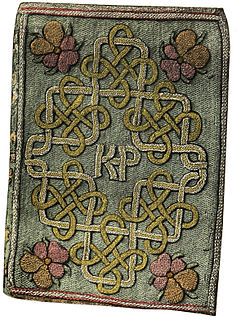
In embroidery, plainweave is a technical category of woven base fabrics that are suitable for working certain varieties of embroidery. Plainweave fabrics have a tight weave and individual threads are not readily visible. Surface embroidery may be performed on plainweave, such as crewel work, goldwork, stumpwork, cutwork, and candlewicking.

Ottoman is a crosswise rib pattern with a pronounced ribbed or corded effect, may be knitted or woven. Ottoman is a stiff, heavyweight, crosswise rib structure. In weaving it is a warp faced fabric showing bold weft way rib. The ribbed effect is created by using fine warp yarn with a heavier weft yarn. In knitting, Ottoman rib pattern is knitted with double jersey machines. The ribs lines in an Ottoman may vary in size from thin to coarser by selecting yarny Yarn count and gauge.
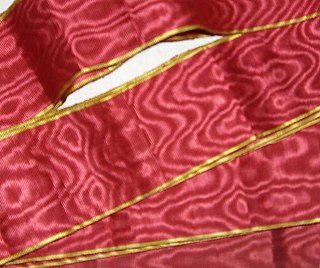
Moire, less often moiré, is a textile with a wavy (watered) appearance produced mainly from silk, but also wool, cotton and rayon. The watered appearance is usually created by the finishing technique called calendering. Moire effects are also achieved by certain weaves, such as varying the tension in the warp and weft of the weave. Silk treated in this way is sometimes called watered silk.
Brilliantine is a lightweight, mixed-fibre fabric popular from the mid-19th century into the early 20th century. Brilliantine can be plain or twill woven with a wool or mohair weft on a silk or cotton warp.

An Arab carpet is an oriental carpet made in the Arab world using traditional Arab carpet-making techniques.
References
 This article incorporates text from a publication now in the public domain : Chisholm, Hugh, ed. (1911). "Rep". Encyclopædia Britannica . 23 (11th ed.). Cambridge University Press. p. 105.
This article incorporates text from a publication now in the public domain : Chisholm, Hugh, ed. (1911). "Rep". Encyclopædia Britannica . 23 (11th ed.). Cambridge University Press. p. 105.


